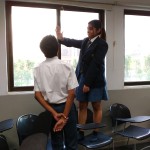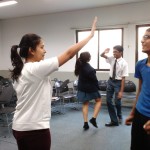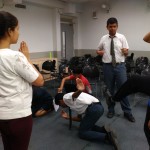I was meeting the Human Rights defenders at South City International School after a long break(thanks to final exams), and thought that some theatre would be a good way to get back into the swing of things.
We started off with some warm up exercises led by one of the students who plays in the football team. We then moved onto a commonly used theatre exercise which involves walking around in the space that you have. We started off with walking slowly, making no eye contact, and being careful not to make any physical contact either. We then moved onto walking in the space, only this time, making eye contact, turning the speed of walking up a notch every few minutes.
‘ It was weird’, said one of the students when I asked them what it felt like doing this exercise. The other agreed. Some thought it was ‘weirder’ making eye contact.
We moved onto an exercise called ‘ Columbian Hypnosis’. The group divided up into pairs, one the leader and the other, the follower. The leader holds up his/ her palm in front of the follower, who then has to essentially keep their focus on the palm, following it. After awhile, the students started to explore the space that they had, the leaders making the followers climb tables and chairs, and some even used the floor!
A brief discussion about the activity followed. Most of the students liked leading. Some felt that the leaders were being too challenging, and some felt that the level of trust had to high in order to do the exercise.
Following this, I told the group a little about image making, and the role that image theater plays. They them took a few minutes to think of human rights that they would individually depict as an image. There were representations of freedom of speech, religion, the right to education and the right to security.
After this, we moved onto building images as a group. Some of the students found working in a group easier, because they had an image to work on.
What was particularly interesting for me was some of the interpretations that the students had, especially while working on building images in a group. Each added a particular image, which complemented the picture being created very well.
–Paroma Sengupta






